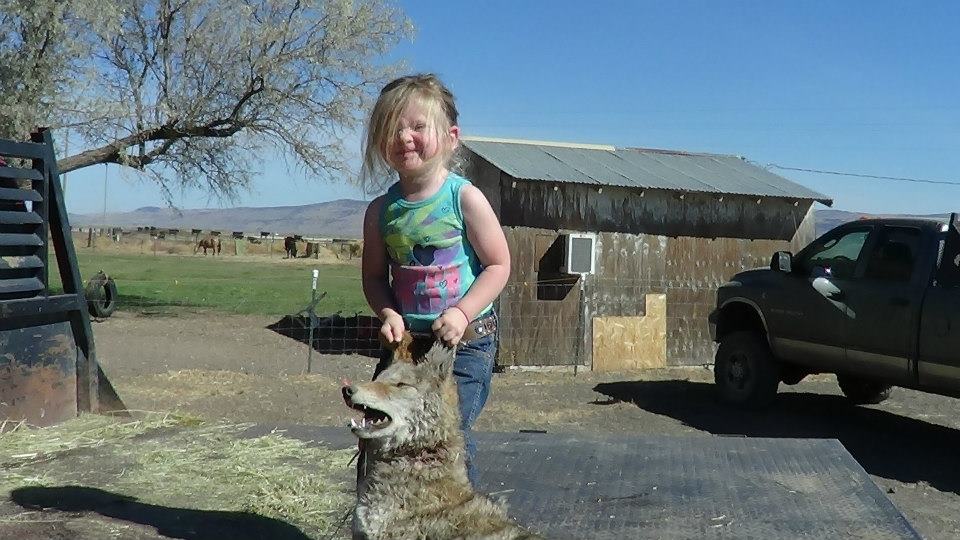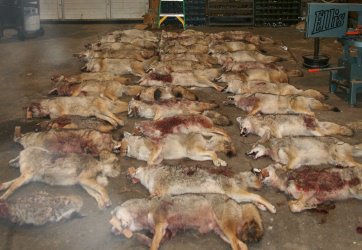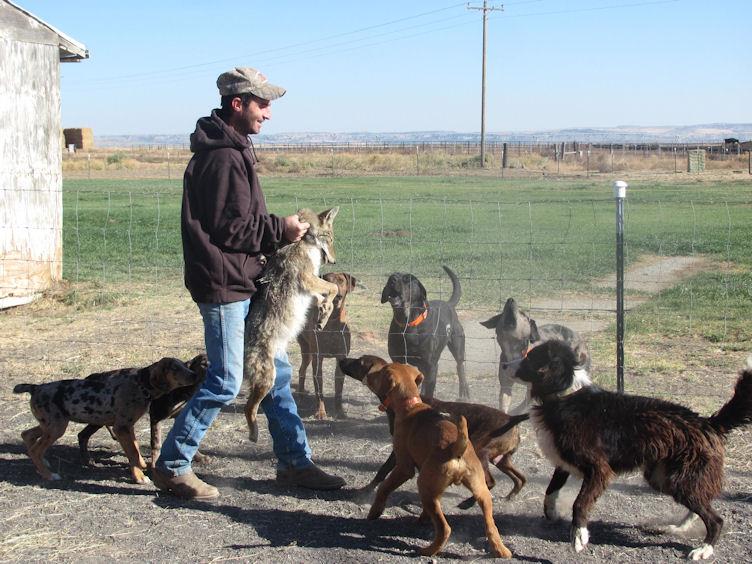Parts One and Two of a public video package designed to end trapping on public lands in NM. Please share with legislators. While made to address trapping in NM, the message is the same for all public lands. The time has come to end trapping.
Tom Knudson (Pulitzer Prize winning reporter) illustrates traps and their destructiveness. They are banned in 80 countries but the US allows widespread use of them, and snares.
America’s trapping boom relies on cruel and grisly tools by Tom Knudson
https://www.revealnews.org/article/americas-trapping-boom-relies-on-cruel-and-grisly-tools/
Check out this site by wildlife photographer John Marriott!
The site contains a series of videos on the corrupted wildlife management process and on trophy hunting.
EXPOSED Episode 1:
Stop the BC Grizzly Trophy Hunt
www.exposedwithjohnemarriott.com
A coyote that was trapped and then transported to a training area. The handler here is likely conducting an illegal activity by throwing the live coyote to his frenzied dogs for “training” or fun but there is little to no enforcement against trapping violations. The trappers Facebook page shows serial abuse of hundreds of animals.
Trapping is a national epidemic that trappers like to call a “cultural tradition”‘. Each year hundreds of thousands of wild animals are killed by traps or snares. The three forms of trapping most often used are snares, body gripping devices and leg hold traps. All three activities were, at one time, used as subsistence hunting methods to provide food and clothing. But the use of subsistence trapping largely ended as commercial trappers emigrated to North America and trapping became a commercial enterprise that wiped out many species like beaver, muskrat, lynx, marten, and even wolves and other species. Trapping effort diminished for a time but now trapping is seeing a resurgence as countries like China want fur. Trapping is not a big industry any longer but the people that practice trapping have a lot of clout through special interest and lobbyists that work hard to protect them and work to enshrine trapping as a cultural tradition to be preserved. Despite public sentiment against trapping, trappers cause great damage to wildlife and make public lands unsafe for wildlife, pets and people. Few regulations exist on the number of snares or traps that can be set, traps in some instances don’t have to be checked for days leaving the animals to suffer, and because trappers can set unlimited traps, a single trapper may kill hundreds, if not more, of unprotected species like coyotes or racoons. Some trapping is done to kill predators and other animals that may be irresponsibly labeled as “nuisance” species; some trapping is done to capture and kill animals for fur, but in some instances trapping and snaring is done just for fun. Other trappers trap coyotes, foxes and raccoons by the hundreds and then transport the animals to other states and sell them to penning facilities where they are used as live bait to train dogs. Worse yet, some trappers hate certain species like wolves or coyotes and enjoy trapping and killing the animals out of revenge. The “cultural tradition” that trappers claim is worthy of preserving is instead a culture of killing, maiming, torture and inhumanity that has no place in today’s world. Please watch for anti-trapping initiatives and sign them. This insidious activity, that is banned in most European countries, still flourishes in North America.
We believe that as trapping is exposed as a legal activity Americans express shock, and outrage. We also believe that legislators ignore the majority to appease minority special interests and that this is wrong. Trapping has no place in our public lands, wildlife refuges, and national parks. Its time to end trapping nationwide and globally. Please read letters from average Americans that have learned about trapping and their thoughts on the subject.


Partial directory and reports of non target species and animals caught in traps
http://www.zaxtor.net/
Often people become outraged when pets die. As terrible as this is, no animal domestic or wild should suffer in traps. Trapping for forbearing animals is unconscionable torture to sentient, intelligent beings.
Trapping: A Culture of Killing From One Generation To the Next…
From Montana
The brain, ethics and trapping (Bitterroot Star)
http://www.bitterrootstar.com/2014/05/02/the-brain-ethics-and-trapping/
In the last ten years more has been learned about the brain and how it functions than in the preceding several centuries. In the 1960’s, neuroscientists were able to divide the brain into three parts. Two of these, the basal ganglia and the limbic system share common structure and functions in all mammals from rats to humans It is within the limbic system that the thalamus and the amaydala lie, which play the major role in the brain functions associated with pain and emotion. Those emotions include the ones we call fear, grief and anguish.
Think of yourself going about your normal daily activities. Suddenly, with great speed and force, the steel jaws of a Conibear trap spring closed around you from where it was concealed. Impacting your body the trap performs as designed. It crushes your skull, your vertebra or other vital body parts. Or perhaps you become the victim of a leg hold trap. You struggle to free yourself, the traps jaws dig into your flesh sending spasms of pain up your leg. In your desperation to free yourself you bite at the steel, injuring your mouth. Your struggles may result in your dislocating your leg, twisting it off, or you may even gnaw it off in an effort to escape. Unable to extricate yourself, you are (legally) left exposed to the elements vulnerable to frozen appendages, dehydration, starvation and predation. If you survive this, your likely fate is to be bludgeoned to death or, if fortunate, shot. The primary goal is not to end your suffering but to preserve your marketable hide. Perhaps you’ve gone for a swim only to be caught by a trap holding you under water. Despite your panicked struggles, made in vain, you cannot reach the surface for life supporting air. You die of hypoxia. Or, you’re an offspring dependent for your survival on a parent that has been caught in a trap. Your fate now is to die a lingering death from malnutrition. You may just be one of the countless collateral victims of trapping. Anthropomorphizing aside, this reveals the pain and suffering inherent in trapping.
We clearly recognize such acts as constituting torture, being inherently inhumane and morally unacceptable were they perpetrated against us. For years many believed, without any evidence, that only humans feel pain or emotions. We now know better. Dennis “Foothold” Schutz, former Vice President of the Montana Trappers Association, stated, “We trappers do cause pain and suffering to animals and we apologize to no one.” While Mr. Schutz recognizes the pain and suffering inflicted on the animals trapped, this is perfectly acceptable to him. He doesn’t care what anyone thinks.
There is a part of the mammal brain, the cerebral hemispheres with their outer layer the neocortex, which in humans has developed to a higher degree than in other mammals. This is where the higher thought processes, the ability to associate words with thoughts, the ability to problem solve and the ability to develop ethics, morality and a conscience lie.
Unlike hunting and fishing which are regulated for personal consumptive use, trapping is a commercial activity. The demand for the products, furs and cosmetics, significantly from Russians and Chinese, is driven by a desire for styles showing status and feeding vanity. There are numerous clothing alternatives to the skins of animals. Does our ethics, morality and our conscience allow us to condone an activity which causes pain and suffering in order to supply this market? In 1789, Jeremy Bentham, a major figure in formulating Anglo-American philosophy of law, wrote in Introduction to the Principles of Morals and Legislation, “The question is not, Can they reason? Nor Can they Talk? But, Can they suffer?” The wildlife in our state belongs to all Montanans. We each have a responsibility for its well being, and that depends on the laws we enact. I urge you to support ballot initiative I-169, for Trap Free Montana Public Lands, in order that all Montanans can vote this November, on whether they want our public lands, only one third of Montana, trap free for people, pets and wildlife. For more information and to help visitwww.trapfreemt.org.
Cindy Warden
Hamilton
Trapping: allowing cruel practice is nuts (Missoulian)
http://missoulian.com/news/opinion/mailbag/trapping-allowing-cruel-practice-is-nuts/article_53c79c34-d225-11e3-91c1-001a4bcf887a.html
May 04, 2014 6:45 am
I have recently become aware that the archaic and cruel method of trapping has been used on the Lee Metcalf Wildlife Refuge in Stevensville. I find that completely against the intentions for which wildlife refuges were founded. If it is necessary to control beaver populations in a refuge, I would prefer a ranger give a quick shot to the head of the beaver. To kill an animal in such a way that it suffers and could possibly be discovered by someone like me who goes to a refuge to enjoy myself is a horrific thought.
The following is a definition of a National Wildlife Refuge:
“The National Wildlife Refuge System is the system of public lands and waters set aside to conserve America’s fish, wildlife and plants.”
In my opinion, so-called public lands become much less public with the fear of traps on one’s mind.
This is the definition of the word “refuge”: a condition of being safe or sheltered from pursuit, danger or trouble.
That being said, I can’t begin to express my anger and disappointment that the Lee Metcalf Wildlife Refuge would allow the cruel method of trapping within the bounds of a wildlife refuge.
I am a teacher and bring my students to the refuge once or twice a year. I walk my dogs in the refuge. I will rethink both of those activities knowing that traps are there. I will also certainly rethink any monetary support of the national wildlife refuges as long as trapping is allowed, even on a limited basis.
Whoever made the decision that trapping should be allowed in a national wildlife refuge is, in my opinion, absolutely nuts. Horrible decision.
Nancy Fisher, Stevensville
Lee Metcalf Refuge lies, kills animals (Missoulian):
http://missoulian.com/news/opinion/mailbag/trapping-lee-metcalf-refuge-lies-kills-animals/article_6c6932c0-d225-11e3-9fea-001a4bcf887a.html
May 04, 2014 6:45 am
On April 21 at the Lee Metcalf National Wildlife Refuge in Stevensville, I walked the Kenai Trail and by the blind where you can sit and get pictures of wildlife, I discovered a beaver, snare-trapped and drowned in the water.
I called the refuge office and was told it was arranged by management because if the beavers interfere with managing the water for ducks then they have to use management action and do this. The trapper was supposed to come get it early in the morning and didn’t.
This is done on a refuge and the snare traps can kill anything. I was a trail volunteer there for three years – I quit. I refuse to be a volunteer while they do this and lie to people.
A refuge is a sanctuary for wildlife. This refuge is killing them – beavers, raccoons, skunks and coyotes. There are more traps out to do this.
I have no respect for them. They should be ashamed of themselves for the jobs they have and where.
Kimi Smith, Stevensville
